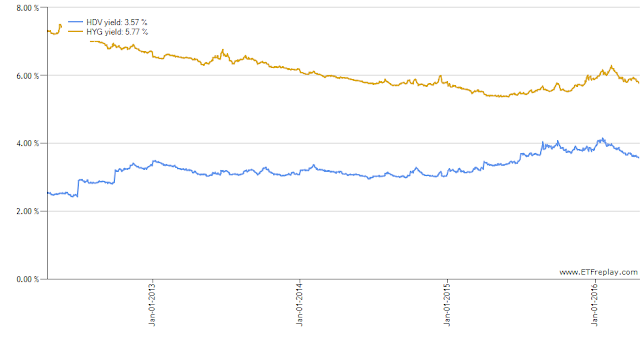High yield bonds have had a major recovery since the ugly
2014 (measured in total return HYG the largest high yield ETF is up over 8% in the past 3 months) showing that they are an asset class that only works for long term
investors. Further complicating matters is the fact that changes in the bond
market with dealers holding last inventory and less willing to take risks after
market makers have reduced liquidity in this market. Less liquidity means more
volatility and of course the liquidity dries up just when performance chasing
investors want to sell creating a vicious cycle.
Unlike Treasury bonds or even investment grade high yield
bonds won’t form a buffer to a portfolio in times of crisis. But they may offer an attractive addition to
a portfolio as an asset with risk between those of stocks and those of treasury
bonds and investment grade bonds. The NY Times recently presented a good overview of the high yield bonds' role in a portfolio,
With US stock valuations high based on historical measures
and yields on junk bonds—despite the recent rally—well above long term averages
it may still be a good opportunity to add high yield bonds to a portfolio. In
the long term asset classes show a reversion to the mean in valuations with US
stocks at high historic valuations and high yield bonds – even after their
recent rally— are still at relatively low valuations it may be a time to consider
incorporating high yield bonds in a portfolio allocation…but only for those who
consider it as part of a long term investment strategy.
As is the case in most asset classes investors tend to chase
performance and thus miss out in the long term returns. This is certainly the
case with high yield bonds. Below are graphs of fund flows and below that
changes in yield spreads –the differential between high yield and investment
grade vs treasury bonds, lower spreads mean higher prices.
Nor surprisingly the flow of investor money chases
performance with outflows at the bottom in price (high in spreads) and vice
versa.
:
And here is a chart of the high yield bond ETF HYG as can
been seen high yield bonds are not for the faint of heart. Matching this chart
against the flow of funds chart above shows the outflows matched price declines
and the inflows chased the advances in price. One can observe here a spikes up in volume (bottom scale)at the lowest price levels..indicated large scale selling..
.
On the other hand, disciplined investors who allocate a
portion of their assets and use a disciplined rebalancing strategy can reap the
benefits of an allocation to high yield.
Perhaps more than other asset class, high yield bonds have a very clear
pattern of reversion to the mean: when yield spreads move to extreme levels
they return back closer to long term averages. This makes them a particularly
good asset to benefit from those that use discipline in rebalancing. Selling part of the allocation after large
increases in price (spreads well above the mean) and vice versa gives excellent
opportunity for a “rebalancing premium” in this asset class…as well as reducing
risk.
Here is a longer term chart of credit spreads.
So where do High Yield bonds belong in a portfolio. A recent
NYT article discusses this. High yield bonds fall somewhere between stocks in
terms of risk and return. Given the attractive cash flows from such investments
and lower volatility than stocks they might be seen as an attractive
alternative to dividend and dividend growth stocks in generating cash flow from
a portfolio. For example, at present HYG currently carries a yield of 5.77% vs
3.57% for HDV the high dividend ETF and has consistently carries a yield well
above that of HDV. Below is a three-year graph of the yields for HYG and HDV
A few more graphs of interest.
Long term chart of total return (growth of $1) high yield
index vs US stocks (Russell 3000 index), US investment grade bonds and US treasury bonds
And the risk return graph used to show the “efficient frontier”
how asset classes line up in terms of risk and return.
 |
The graph shows that
in fact high yield investors are compensated for the risk they take relative to
treasury bonds. And that the risk/return is between that of US stocks (Russell
3000) and the US treasury bonds. In fact, the risk return tradeoff (added risk
vs increased return) high yield bonds look attractive compared to credit bonds indices which include investment grade and high yield. That is logical since in times of financial crisis spreads between
both investment grade and high yield bonds both widen considerably (decline in
price) during periods of financial stress. As many have observed the only thing that goes up in such markets is correlation among risk assets. Only treasury
securities and cash offer a shelter in those conditions.
The long term disciplined investor can benefit from a long
term allocation to high yield bonds…but only for those with the fortitude to
hold on to their allocation during periods of share declines. And disciplined
enough to sell high and buy low in rebalancing.
Current high historic valuations for US stocks and low
historic valuations for high yield bonds may make it an opportune to consider
initiating such an allocation.





No comments:
Post a Comment